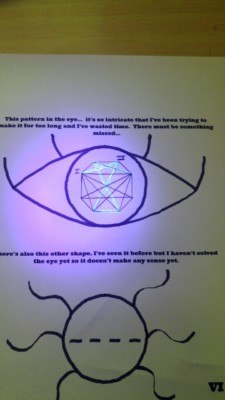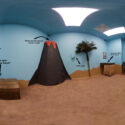When he began building and programming escape rooms, it was like Bane Srdjevic was coding his fantasies.
He created a room where you play with a giant laser. In another at Lock Chicago, the escape room complex Srdjevic co-owns, there is the Japanese Zen room, influenced by Srdjevic’s time teaching in Japan.
And then there’s Sunburn. The initial idea for that room came after Srdjevic watched The Mummy, where a character illuminates a tomb by bouncing light off of mirrors. Now players “have to figure out how to use this one big contraption in the very middle of the room, in which you bounce laser beams off of mirrors to find designs and patterns that fit together,” Srdjevic says.

Photo courtesy of Bane Srdjevic
Srdjevic isn’t the only one using a little bit of inspiration to create complex puzzle rooms. Escape rooms are having a bit of a boom right now, with new rooms popping up across the country. The growth has been exponential. When Lock Chicago opened its doors in 2015 it was only the third escape room in Illinois. Now it is one of over 40 escape room companies in the state.
The whole concept began as an online game called Crimson Room in 2004 where the player had to point and click to open draws and clues. Three years later a company in Japan made the virtual real, opening the first live escape room in Kyoto. It spread from there, each new room trying to create a unique, immersive, physical experience that challenges each group that enter.
“For an hour, we are the entertainment,” says George Ackley, an escape room reviewer, and founder of the blog LockedinReviews. “In the very first room we did, we escaped with 59 seconds left, and we were hooked … on the endorphin rush. We did a second one that night, and my wife and I took a couple friends to another one the very next day.”
Now his review website is a year old, and Ackley and his wife travel throughout New Jersey reviewing rooms on theme, puzzle design, and customer experience.
Building rooms to meet all of that criteria isn’t easy. Immersive Tech, an escape room creation company in Vancouver, Canada, has anywhere from seven to 11 people working on a project at one time. The typical 60-minute escape room design package is $12,500. That excludes props and fabrication costs. A typical timeline is three months from start to finish.
“Ideas are always the number one challenge when it comes to design,” says Andrew Myers, the lead designer for Immersive Tech. “But here, we’re always trying to push the envelope on what exactly an escape room can be.”
Immersive Tech works with escape room companies and business franchises looking for custom, off-site rooms. They can create game flow for groups as little as three, to over one hundred. Their business, which began in 2014, is customer-driven. And the company is always learning from its clients — incorporating their technology and puzzle requests into escape rooms.
“That’s the one thing that’s true of all rooms,” Srdjevic says. “Throughout its life, we are always tweaking things, like moving signs from one side to the other, or taking out some puzzles but adding new ones. Before launch, we want to make sure that the room is functioning, and after [launch] it’s about making sure it’s the best it can possibly be, which means tweaks.”
Lock Chicago operates with three people: Srdjevic, Brian Lee, and Alex Wilson. Between the three of them, escape rooms go from ideation to completion. The three friends spent a few months testing out escape rooms before deciding to “give their own a try” in 2015.
They built Sunburn in a month and a half. Their second room, Malfunction, was thought up and fully designed by Srdjevic in one day, but it took them four weeks to build. The third, Matsuri, took them four months. Regardless, they’re usually working up until the moment the first customers walks in the door.
“In the case of Malfunction, our first group was scheduled to play at 11:30 on Saturday morning, and the three of us put the finishing touches on the room at 11:28 a.m.,” Srdjevic says.
The Suspense, Down to the Puzzle
The Island Escape at Breakout Des Moines. Move your cursor around on the photo to see the room set up upon entry. Photo courtesy of Olivia Decelles
When my team and I first entered Island Escape at Breakout Games in Des Moines, I was taken aback by its intense brightness. We took note of the four visible locks and a conspicuously large chest on the ground, which we couldn’t open, despite its lack of padlock. When the clock started ticking, we had no idea where to start. As the 10 minute warning went off, we were at the bridge of the ship — locks, word clues, and miniature treasure chests strewn all over the floor. Lights were on, lights were off. Curse words were uttered a time or two. I was yelling out numbers, another was toying with the locks.
With less than five minutes on the clock, we punched four numbers into the keypad, a lock clicked, and we heard our gamemaster yell excitedly over the intercom that we did it. Our heart rates were over 100 BPM each. Our high fives were sloppy, maybe a touch sweaty.
And that’s the whole point of an escape room: to get so lost in the story that your adrenaline kicks in. Even though escape rooms all tend to have similar elements across the board — keys and locks, numbers to organize, and word puzzles — it’s the way the story unfolds that constitutes difference.
Srdjevic graduated Purdue University with a creative writing degree, which subconsciously affects the way he lays out his rooms. Logic, organization, and storytelling must all be present for the experience to truly be immersive.
“There need to be layers of reveal to each puzzle,” Srdjevic says. “A basic example is, ‘Put key in lock to solve.’ But the fun ones involve more steps, like, ‘Find a key in this place, which reveals a clue to which padlock it pairs with, and then there’s a riddle to figure out where that lock is.’”
Srdjevic calls it “absolute logic.” “When players figure out the steps, we want them to say, ‘Oh my God, that’s so cool, how did they do that?’” he says.
Creating Unique Spaces
The “magic” players see in escape rooms really comes down to the wiring. “Most of it isn’t programming, it’s completing a circuit,” Srdjevic says.
Placing three objects on a table in a certain order that triggers a door to open is one example; “Say there is a wire that’s cut in a couple places, and when you place an object in a certain place, a magnet pops up and connects the two wires together to keep the current going, and once all the right objects are in place, it will power the motor, and the motor then activates,” Srdjevic says.
Another part of the “magic” is the story. Srdjevic says the worst thing owners can hear someone say in an escape room is, “‘Oh, it’s this again.’” Every puzzle, theme, or story needs a bit of flare, unique to its creator.
For Immersive Tech’s Myers, the creativity is really dependent on his fellow game designers and their brainstorming sessions. Just like being a participant in the escape room, it’s all about working together.
“We start by writing words on the wall and seeing if themes jump out at people,” Myers says. “A lot of times we think of things really general, like, ‘it would be cool if we included aliens,’ and we move along that thought process with questions like, ‘what could the aliens do, or what do they entail?’ Focusing in on one idea until we get something really good helps overcome design block.”
But the thing that truly makes escape rooms stand out, at least for Srdjevic, are the people. They have to work together. They have to communicate. They completely control the outcome. “They are actors in their own play,” Srdjevic says, “and that’s a really freeing experience.”
And that’s what brings people back over and over again.

